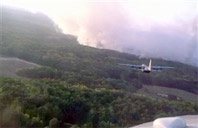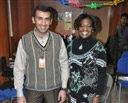DOD Teachers Take on Mission in Afghanistan
WASHINGTON, Jan. 13, 2011 – Judy Ryan has taught English as a second language in five countries over the past 15 years, but this is her first year teaching in a war zone.

Courtesy photo | Thomas Wiglesworth, a teacher with the Department of Defense Education Activity, speaks English with students as they explore an aircraft during a Kandahar, Afghanistan, open house, Jan. 1, 2011. Wiglesworth is deployed in Afghanistan for a year to teach English to Afghan security forces and other personnel.
Thomas Wiglesworth, a teacher with the Department of Defense Education Activity, speaks English with students as they explore an aircraft during a Kandahar, Afghanistan, open house, Jan. 1, 2011. Wiglesworth is deployed in Afghanistan for a year to teach English to Afghan security forces and other personnel.
Ryan, a Department of Defense Education Activity teacher, is on a one-year deployment to Afghanistan to teach English to Afghans. She’s stationed on Camp Morehead in eastern Afghanistan, surrounded by an Afghan commando training base, from which she draws many of her students.
“The students are highly motivated,” Ryan said. “[They] make it a joy to walk into the classroom every day, because I know that they will give 100 percent each and every day.”
Ryan is one of five DODEA teachers who volunteered to deploy to Afghanistan in support of NATO Training Mission Afghanistan’s education division, tasked with providing English instruction to Afghan security forces and other military personnel.
The DODEA teachers work on a mobile training team alongside nine teachers from the Defense Language Institute in San Antonio, augmented by about 50 Afghan English teachers. Scattered at austere, remote bases throughout Afghanistan, including sites in Kabul, Kandahar and Morehead, these educators teach English to members of the Afghan National Army and Afghan National Police, and civilians from the defense and interior ministries.
The importance of her work helps to overshadow some of the more challenging aspects of the job, Ryan said.
“Life here can be very difficult, sometimes scary and dangerous,” she said. “But it’s easy to put those difficulties aside and ‘suck it up,’ because you know that what you are doing is important.”
The team’s goal is to help fill training seats, mostly for military and military-related training in the United States, explained Pamela Tucker, a DODEA teacher who serves as team chief. But to be considered, students first must meet a 70-percent literacy rate requirement.
“Many of our students begin at the very basics of our language: phonics,” said Tucker, who teaches secondary language arts at the Robert D. Edgren High School in Misawa, Japan.
Although stationed in Kabul as team leader, Tucker often travels from site to site across the country. She cites maintaining security and creating a sense of normalcy in an “un-normal environment” as two of her toughest challenges, but is fortunate to have some experience with both.
Tucker packed away her uniform in August to serve this deployment as a civilian, and she brings to the table her extensive experience as a staff sergeant in the Army Reserve. She has served since 1999, and has deployed to Honduras, Africa, South Korea and Iraq.
“I feel fortunate to be a member of both families,” she said referring to her military background and her current civilian role. “It takes both populations to drive the mission forward.”
One of Tucker’s team members, Brenda Colom, represents the flip side of the house — she’s on her first deployment. A 36-year DODEA teacher, Colom jumped at the opportunity to serve in Afghanistan. She had wanted to pitch in to help others since hearing about the earthquake in Haiti last year.
“This is the most exciting teaching [assignment] I have ever had,” said Colom, who teaches biology and health at Bitburg High School on Spangdahlem Air Base, Germany. “The students want to learn; they’re so motivated.”
It’s also the most intensive teaching she has encountered, she said. Students and teachers spend about eight hours at a time learning English. “They realize that learning English is the key to improve their personal lives and their country,” she said.
As the only female teacher at the Kabul English Language Training Center, Colom said she’s been able to connect with the five female students there. The team only recently began teaching women at its schools, Tucker added.
Colom said she knew she was making an impact, not during, but after her students graduated from her class. Although they had passed, she said, they kept coming to class — day after day.
“I was finally assigned a new group of students, and I volunteered to move to another classroom, so my original class got the hint that I was moving on,” she said.
Thomas Wiglesworth, a DODEA teacher at Andersen Elementary School on Andersen Air Force Base, Guam, who’s now stationed at Kandahar Airfield, said he marks progress even in the most everyday occurrences. A simple conversation in English over a shared cup of tea, for example, can be a surprisingly effective indicator of success, he said, noting he’s had “innumerable” cups of tea.
“I know they have come a long way in their language abilities when they take the time to try to share their stories with me in English, … [telling me] their personal life stories, sorrows, hopes and aspirations,” Wiglesworth said.
Wiglesworth noted his pride in several of his students. A command sergeant major he taught cut back significantly on interpreter support after instruction, he said, and another student, the wing commander, used English when addressing a crowd at an open house.
Other students are on the verge of qualifying for a seat at a U.S. training class, he added.
“They have great hearts and big dreams,” Wiglesworth said of his students. “I am grateful for having the opportunity of having a small impact on helping them reach those ambitions and dreams. With men like this, Afghanistan’s future is very bright.”
Over on Camp Morehead, five of Ryan’s students have qualified to attend training in the United States, marking a huge accomplishment for the school, which just opened last year, as well as for her Afghan students.
“They know what great skills they will learn and how these skills will help them in the fight against the Taliban,” she said. “They are all so dedicated to helping their country.
“This country needs so much help,” she added. “In spite of the difficulties, knowing that I contributed even a small piece is something that I will always treasure.”
Related Sites:
Department of Defense Education Activity
 Brenda Colom, a teacher with the Department of Defense Education Activity, poses with some of her Afghan students from the Kabul English Language Training Center in Kabul, Afghanistan, in January 2011. Colom is deployed in Afghanistan for a year to teach English to Afghan security forces and other personnel. Courtesy photo; Download screen-resolution; Download high-resolution
Brenda Colom, a teacher with the Department of Defense Education Activity, poses with some of her Afghan students from the Kabul English Language Training Center in Kabul, Afghanistan, in January 2011. Colom is deployed in Afghanistan for a year to teach English to Afghan security forces and other personnel. Courtesy photo; Download screen-resolution; Download high-resolution
 Judy Ryan, a teacher with the Department of Defense Education Activity, poses with some of her Afghan students at Camp Morehead, a remote base in eastern Afghanistan, in January 2011. Ryan is deployed in Afghanistan for a year to teach English to Afghan security forces and other personnel. Courtesy photo; Download screen-resolution; Download high-resolution
Judy Ryan, a teacher with the Department of Defense Education Activity, poses with some of her Afghan students at Camp Morehead, a remote base in eastern Afghanistan, in January 2011. Ryan is deployed in Afghanistan for a year to teach English to Afghan security forces and other personnel. Courtesy photo; Download screen-resolution; Download high-resolution
 Pam Tucker, a teacher with the Department of Defense Education Activity, poses with an Afghan English teacher in Kabul, Afghanistan, in January 2011. Tucker oversees a mobile training team that includes five DODEA teachers. Courtesy photo; Download screen-resolution; Download high-resolution
Pam Tucker, a teacher with the Department of Defense Education Activity, poses with an Afghan English teacher in Kabul, Afghanistan, in January 2011. Tucker oversees a mobile training team that includes five DODEA teachers. Courtesy photo; Download screen-resolution; Download high-resolution




























